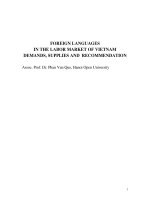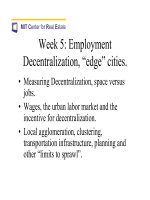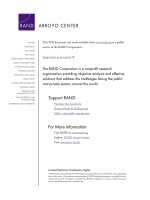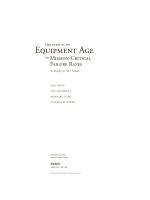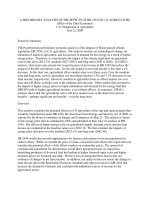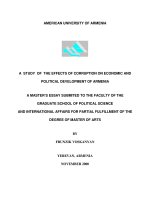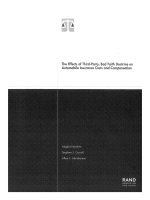THE EFFECTS OF FDI ON THE LABOR MARKET OF ASEAN COUNTRIES
Bạn đang xem bản rút gọn của tài liệu. Xem và tải ngay bản đầy đủ của tài liệu tại đây (2.1 MB, 129 trang )
1
MINISTRY OF EDUCATION AND TRAINING
FOREIGN TRADE UNIVERSITY
MASTER THESIS
THE EFFECTS OF FDI ON THE LABOR MARKET
OF ASEAN COUNTRIES
Specialization: International TradePolicy and Law
HO THI HONG NGAN
2
Hanoi - 2019
MINISTRY OF EDUCATION AND TRAINING
FOREIGN TRADE UNIVERSITY
MASTER THESIS
THE EFFECTS OF FDI ON THE LABOR MARKET
OF ASEAN COUNTRIES
Specialization: International Trade Policy and Law
Full name: Ho Thi Hong Ngan
Supervisor: Dr Nguyen Thi Viet Hoa
3
Hanoi - 2019
1
DECLARATION
I hereby declare that this master thesis is the scientific research of my own which
made on the basis of theoretical studies, field surveys and under the direction and
supervision ofDr. Nguyen Thi Viet Hoa. The research contents and results of this
thesis are completely honest. These data and documents for the analysis, review and
evaluation were collected from various sources which are fully listed in the
reference list.
I am fully responsible for the content of this master thesis as well as this
declaration.
Hanoi, 21 February 2019
Author
Ho Thi Hong Ngan
2
ACKNOWLEDGEMENT
During the completion of this master thesis, I received the guidance and valuable
help from the lecturers, siblings and friends. With great respect and deep gratitude, I
would like to express sincere thanks to:
Dr. Nguyen Thi Viet Hoa who wholeheartedly helped, supported and encouraged
me from the initial to the final level of this dissertation. She provided me with
comprehensive guide from choosing the topic, outlining the thesis and editing this
research.
Professors and lecturers from FTU as well as World Trade Institute in the Master of
International Trade Policy and Law Intake Four, who not only spread profound
knowledge and information in the fields of economy and law but generated strong
motivation for me while I was taking this course as well.
Last but not least, I would like to express my sincere thanks to my family, my
colleagues and my friends, who have always by my side encouraging, supporting,
contributing valuable ideas and giving me favorable conditions for me to complete
this scientific research.
3
TABLE OF CONTENTS
DECLARATION.....................................................................................................ii
ACKNOWLEDGEMENT....................................................................................iiii
LIST OF ABBREVIATIONS..............................................................................vivi
LIST OF FIGURES........................................................................................viiiviii
SUMMARY OF THESIS RESEARCH RESULTS...........................................ixix
In some certain aspects, the author has answered all the questions which have
been raised when considering about the topic.The characteristics of foreign
direct investment and labor market have been listed and analyzed carefully.
The effects of foreign direct investment (FDI) on the labor market of ASEAN
countries are quite mixed and need to be further analyzed by in-depth models.
In general, FDI has brought positive impacts on the labor market of ASEAN
countries, but these effects are not well adapted due to both subjective and
objective reasons. The labor force of ASEAN still faces a lot of difficulties in
taking advantage of huge FDI capital from outside. Therefore, some solutions
have been proposed to help ASEAN labor force in general and Vietnamese
labor in particular get access to this type of investment and gradually raise
their capabilities to work abroad.......................................................................ixix
CHAPTER 1: INTRODUCTION.........................................................................11
1.1. Research Rationale......................................................................................11
1.2. Literature Review........................................................................................44
1.3. Research objectives.....................................................................................77
1.4. Research questions......................................................................................77
1.5. Scope of research.........................................................................................88
1.6. Research methodology................................................................................88
1.7. Thesis outline...............................................................................................88
CHAPTER 2: THE THEORETICAL FRAMEWORK OF THE EFFECTS OF
FDI ON THE LABOR MARKET....................................................................1010
2.1. Fundamentals of FDI..............................................................................1010
2.1.1. The concept of FDI............................................................................1010
2.1.2. Characteristics of FDI.......................................................................1212
2.1.3. Classification of FDI.........................................................................1313
2.2. Fundamentals of labor market...............................................................1515
4
2.2.1. The concept of labor market..............................................................1515
2.2.2. Composition of labor market.............................................................1817
2.2.2.1. Labor supply...........................................................................1817
2.2.2.2. Labor demand.........................................................................2020
2.2.2.3. Labor cost...............................................................................2120
2.2.3. Functions of labor market.................................................................2221
2.2.4. Characteristics of labor market.........................................................2222
2.2.5. Classifications of labor market..........................................................2626
2.3. Theoretical framework of the effects of FDI on the labor market.......2827
CHAPTER 3: EFFECTS OF FDI ON THE LABOR MARKET OF ASEAN
COUNTRIES.....................................................................................................3030
3.1. Current situation of FDI into ASEAN countries...................................3030
3.1.1. ASEAN is one of the most attractive destinations for foreign investment
of the world..................................................................................................3030
3.1.2. Major Powers in the world invest more in ASEANdue to the strong
internal force...............................................................................................3131
3.2. Current situation of the labor market of ASEAN countries.................3535
3.2.1. Abundant and young labor force.......................................................3535
3.2.2. Lack of skilled workers....................................................................3737
3.2.3. Facing a lot of difficulties..................................................................3838
3.3. Effects of FDI on the labor market of ASEAN countries.....................3939
3.3.1. Effects of FDI on labor cost..............................................................4040
3.3.2. Effects of FDI on labor demand……………………………………….44
3.3.3. Other effects of FDI...........................................................................4445
3.3.3.1. Effects on productivity.............................................................4445
3.3.3.2. Effects on inequality................................................................5252
3.3.3.3. Effects on working environment..............................................5858
CHAPTER 4: RECOMMENDATIONS FOR VIET NAM ‘S LABOR
MARKET...........................................................................................................6263
4.1. Perspectives of attracting FDI into Viet Nam........................................6263
4.1.1. Top investment destination in ASEAN..............................................6263
5
4.1.2. Focus on the quality of FDI projects................................................6364
4.2. Some experiences from ASEAN countries.............................................6565
4.3. Recommendations for attracting FDI to strengthen the positive effects of
FDI on the labor market of Vietnam.............................................................6869
4.3.1. Promote the investment environment of Vietnam to attract FDI inflow
...................................................................................................................... 6970
4.3.2. Hold annual meetings/seminars to exchange and learn between
Vietnamese and foreign businesses and vice versa to increase joint ventures
...................................................................................................................... 7171
4.3.3. Encourage the use of Vietnamese labor at all levels of management in
the FDI enterprises......................................................................................7273
4.3.4. Introduce foreign universities / vocational schools to invest in Vietnam
to improve the quality of education in Vietnam..........................................7374
4.3.5. Promulgate legitimate policies to protect the right of labor force....7475
4.3.6. Raising awareness of the workers about MRAsand exploring the
possibility of extending MRAS to more sectors...........................................7576
4.3.7. Reducing protection for domestic labor in AEC...............................7777
CHAPTER 5: CONCLUSION.........................................................................7879
REFERENCES..................................................................................................8283
DECLARATION...................................................................................................... i
ACKNOWLEDGEMENT...................................................................................... ii
LIST OF ABBREVIATIONS................................................................................. vi
LIST OF FIGURES.............................................................................................. viii
SUMMARY OF THESIS RESEARCH RESULTS............................................. ix
CHAPTER 1: INTRODUCTION........................................................................... 1
1.1. Research Rationale........................................................................................ 1
1.2. Literature Review.......................................................................................... 4
1.3. Research objectives........................................................................................ 7
1.4. Research questions........................................................................................ 7
1.5. Scope of research........................................................................................... 8
1.6. Research methodology.................................................................................. 8
6
1.7. Thesis outline................................................................................................. 9
CHAPTER 2: THE THEORETICAL FRAMEWORK OF THE EFFECTS OF
FDI ON THE LABOR MARKET......................................................................... 10
2.1. Fundamentals of FDI................................................................................... 10
2.1.1. The concept of FDI.................................................................................10
2.1.2. Characteristics of FDI.............................................................................12
2.1.3. Classification of FDI...............................................................................13
2.2. Fundamentals of labor market................................................................... 15
2.2.1. The concept of labor market...................................................................15
2.2.2. Composition of labor market..................................................................17
2.2.2.1. Labor supply..............................................................................17
2.2.2.2. Labor demand............................................................................20
2.2.2.3. Labor cost...................................................................................20
2.2.3. Functions of labor market.......................................................................21
2.2.4. Characteristics of labor market...............................................................22
2.2.5. Classifications of labor market................................................................26
2.3. Theoretical framework of the effects of FDI on the labor market...........27
CHAPTER 3: EFFECTS OF FDI ON THE LABOR MARKET OF ASEAN
COUNTRIES.......................................................................................................... 30
3.1. Current situation of FDI into ASEAN countries....................................... 30
3.1.1. ASEAN is one of the most attractive destinations for foreign investment
of the world.......................................................................................................30
3.1.2. Major Powers in the world invest more in ASEAN due to the strong
internal force.....................................................................................................31
3.2. Current situation of the labor market of ASEAN countries.....................35
3.2.1. Abundant and young labor force.............................................................35
3.2.2. Lack of skilled workers...........................................................................37
3.2.3. Facing a lot of difficulties.......................................................................38
3.3. Effects of FDI on the labor market of ASEAN countries..........................39
3.3.1. Effects of FDI on labor costwages..........................................................40
7
3.3.2. Effects of FDI on productivity................................................................43
3.3.2.1. The case of Viet Nam.................................................................44
3.3.2.2. The case of Thailand..................................................................48
3.3.2.3. The case of Indonesia.................................................................49
3.3.3. Effects of FDI on inequality....................................................................51
3.3.4. Effects of FDI on working environment.................................................57
CHAPTER 4: RECOMMENDATIONS FOR VIET NAM ‘S LABOR
MARKET............................................................................................................... 61
4.1. Perspectives of attracting FDI into Viet Nam............................................ 61
4.1.12. Top investment destination in ASEAN..................................................61
4.1.2.3. Focus on the quality of FDI projects....................................................62
4.2. Some experiences from ASEAN countries................................................. 63
4.3. Recommendations for attracting FDI to strengthen the positive effects of
FDI on the labor market of Vietnam................................................................. 67
4.3.1. Promote the investment environment of Vietnam to attract FDI inflow..68
4.3.2. Hold annual meetings/seminars to exchange and learn between
Vietnamese and foreign businesses and vice versa to increase joint ventures...69
4.3.3. Encourage the use of Vietnamese labor at all levels of management in the
FDI enterprises.................................................................................................71
4.3.4. Introduce foreign universities / vocational schools to invest in Vietnam to
improve the quality of education in Vietnam....................................................72
4.3.5. Promulgate legitimate policies to protect the right of labor force...........73
4.3.6. Raising awareness of the workers about MRAs and exploring the
possibility of extending MRAS to more sectors...............................................74
4.3.7. Reducing protection for domestic labor in AEC.....................................75
CHAPTER 5: CONCLUSION.............................................................................. 77
REFERENCES....................................................................................................... 81
8
9
LIST OF ABBREVIATIONS
Abbreviation
Full name
ADB
Asian Development Bank
AEC
ASEAN Economic Community
ALMM
ASEAN
CIT
CLMV
CMS
ASEAN Labor Ministers Meeting
Association of Southeast Asian Nations
Corporate income tax
Cambodia, Laos, Myanmar, Viet Nam
Centre for Multilateralism Studies
EU
European Union
FDI
Foreign Direct Investment
GSO
General Statistics Office
IMF
International Monetary Fund
ILO
International Labor Organization
M&A
Merger and Acquisition
MNEs
Multi-national enterprises
MSEs
Micro and Small Enterprises
MoLISA
Ministry of Labor – Invalids and Social Affairs
MOMT
Ministry of Manpower and Transmigration
MRAs
Mutual Recognition Agreements
NTC
OECD
National Training Council
Organization for Economic Cooperation and Development
OLS
Ordinary Least Square
SMEs
Small and Medium – Sized Enterprises
SOEs
State – Owned Enterprises
PCI
Provincial Competitiveness Index
TNCs
Transnational Corporations
TVET
Technical and Vocational Education and Training
UN
UNCTAD
United Nation
United Nations Conference on Trade and Development
USA
United States of America
VBF
Viet Nam Business Forum
10
VCCI
Viet Nam Chamber of Commerce and Industry
WTO
World Trade Organization
11
LIST OF FIGURES
Figure1. Classification of FDI.................................................................................15
Figure2. The labor market.......................................................................................21
Figure3. FDI flows into ASEAN member states in 2017.........................................31
Figure4. Intra-ASEAN investment, 1995-2016.......................................................32
Figure5. EU FDI flows in ASEAN, 1995-2015.......................................................32
Figure6. FDI in ASEAN..........................................................................................33
Figure7. EU services FDI flows in ASEAN, 2000-2016.........................................33
Figure 8. Labor force in ASEAN member states in 2017........................................36
Figure 9. Labor force growth...................................................................................36
Figure10. Employment share of ASEAN in 2017....................................................37
Figure11. Minimum wage in ASEAN, 2018............................................................40
Figure 12. Monthly wage of Vietnamese workers in Q2, 2018................................42
Figure13. Monthly average wage of Laotian workers, 2017...................................43
Figure14. Productivity growth rate of Viet Nam (in percentage).............................46
Figure15. The gap in absolute productivity between economic sectors (times).......47
Figure16. Capital, attracting labor and raising productivity, 2006-2016..................49
Figure17. Indonesian government employment programs.......................................51
Figure18. Labor market conditions in ASEAN........................................................58
Figure19. Best Places to Work in Viet Nam in 2016, 2017......................................60
Figure20. Attracting FDI to Viet Nam (1988-2017)................................................62
Figure21. FDI in Viet Nam by sectors (2018)..........................................................63
Figure 22. ASEAN Leaders Statement on Human Resources and Skills
Development for Economic Recovery and Sustainable Growth..............................65
Figure23. Priority areas for FDI attraction..............................................................70
12
SUMMARY OF THESIS RESEARCH RESULTS
In some certain aspects, the author has answered all the questions which have been
raised when considering about the topic.The characteristics of foreign direct
investment and labor market have been listed and analyzed carefully. The effects of
foreign direct investment (FDI) on the labor market of ASEAN countries are quite
mixed and need to be further analyzed by in-depth models. In general, FDI has
brought positive impacts on the labor market of ASEAN countries, but these effects
are not well adapted due to both subjective and objective reasons. The labor force of
ASEAN still faces a lot of difficulties in taking advantage of huge FDI capital from
outside. Therefore, some solutions have been proposed to help ASEAN labor force
in general and Vietnamese labor in particular get access to this type of investment
and gradually raise their capaibilities to work abroad.
1
CHAPTER 1: INTRODUCTION
1.1. Research Rationale
Today, in countries with transitional economies, including Vietnam, in
parallel with the expansion of business freedom, the development of
commodity and service market and securities market, labor market is also
being formed.
Economic development is an indispensable goal of all countries to
improve the quality of life of the people. In order to develop economically,
especially in the market economy, it is necessary to develop different types of
markets, as the market is the living environment of the commodity economy.
The labor market is formed and developed in the market economy. It has
relationship with other types of markets: capital market, science and
technology market, information market, monetary market, etc.. The labor
market displays the relations between the employee and the employer, on the
principle of agreement through employment.
Under the ASEAN Economic Community (AEC) blueprint signed in 2007,
ASEAN will “facilitate the issuance of visas and employment permits for
skilled ASEAN and skilled workers engaged in trade activities, cross-border
investment” especially in the four priority areas (air, information technology
(e-ASEAN), health and tourism) as well as logistics. In order to achieve this
goal, functional agencies in each country have come to recognize each other's
education and qualifications and grant "ASEAN experts" certification through
the creation of curricula and acknowledgment of ASEAN. In particular, ten
ASEAN countries have signed Mutual Recognition Agreements (MRAs) under
which ASEAN experts will be allowed to seek employment anywhere in
ASEAN. In 2005, MRA for technical advisory services was the first to be
signed, followed by MRAs in nursing, surveying, architecture, medicine,
dentistry, accounting and tourism. A total of eight expert certificates have been
created. Individuals wishing to look for work abroad can obtain "expert"
certification through the MRA system and continue to apply for a job visa.
2
In addition, the ASEAN Movement of Natural Persons Agreement was
signed in 2012. Through this agreement, foreign nationals seeking immigration
to a country to carry out work related to current job may be granted a work
visa upon completion of certain conditions. Although overall progress has been
made in the region, it is not easy to apply these complex frameworks and
countries' laws have not been updated, limiting the practical implementation of
the system.
The AEC, a framework for the region's economic integration, focuses on a
free labor market that allows skilled professionals to work anywhere they like
across the region, which has a population of 620 million people. The four
objectives of the AEC are: (1) a single market and production base; (2) a
competitive economic region; (3) equitable economic development; and (4)
fully integrated region in the global economy. The free labor market, which
began to take shape in 2015, has freed up eight professions, including medicine,
dentistry,
nursing,
engineering,
architecture,
natural
resources
and
geographical exploration, accounting and tourism, allowing professionals in
these areas to move between countries in the region to work. ASEAN has about
300 million people of a working age, 70 percent of whom are from Indonesia,
the Philippines and Vietnam. A common labor market that the AEC is aiming
at will provide opportunities for skilled workers in the ASEAN region to find
suitable jobs enabling them to develop their careers and provide a rewarding
source of income as well as other benefits.
Currently, in ASEAN, market economy development is placing higher
requirements on the development of the market in general and the labor
market in particular (because the labor market is a decisive market). In fact, in
recent years and now, although the labor markets of these countries have
changed positively: labor supply as well as labor demand has gradually
increased, labor quality has been improved, gradual decline in unemployment,
with the increasing demand of economic development, the labor market of
most of the countries in ASEAN is facing many shortcomings. Due to the
3
varying economic conditions among the ASEAN countries, workers often move
from low-income countries to higher-income countries in search of higher
incomes. It is easy to see a lot of Cambodian workers in the construction
industry of Singapore or Vietnamese workers in Thailand restaurants.
Indonesia and the Philippines have a large workforce and are now facing high
unemployment and low incomes. For these reasons, they tend to move to their
neighbors (Push Force). On the other hand, Thailand and Malaysia have high
living standards and low unemployment rate, attracting workers from the
remaining six countries (Pull Force). The biggest concern for ASEAN
enterprises is the shortage of skilled workers. This seems to be the most serious
problem in finance, ICT and other professional services. Moreover, the demand
for employment in mid-level managers and professionals is very high.
A standout amongst the most pivotal parts of foreign direct investment
(FDI) is its commitment to the economic growth of the host nation. This
commitment is essential and is one that is actually expected by any host nation
particularly developing ones. In the most recent couple of decades, nations
have been contending with one another for the reasons of drawing FDI, this is
due to the essential commitment it makes to the general growth of economies.
FDI not just offers a steady capital flows, but long term commitments to host
nations, insuring a regular capital inflow to host nations. Access to new and
cutting edge technological innovation is potentially a standout amongst the
most vital reasons why a nation would need to draw FDI.
FDI has always played a strategic role in the economic growth of ASEAN
and in many other economic cooperation regions around the world. FDI is seen
as an important channel for obtaining employment opportunities, human
capital development, higher wages, technology transfer, and infrastructure
improvement. In other words, FDI is often seen as a vehicle for an increase in
productivity and efficiency, and consequently as a driver for economic growth.
FDI is likely to have direct and indirect effects on host economies. Increasing
capital formation, employment and trade is the direct effects of FDI, whereas
4
receiving a beneficial transfer of know-how and technology, and management
skills from home country responds to indirect effects of FDI. With the
advantages of cheap labor and capital resources of member countries, ASEAN
has built an attractive business environment for multinational corporations
seeking profits through the implementation of different channels of FDI. With
aforementioned advantages as well as drawbacks of labor market, ASEAN
countries need to work closely to reduce transaction costs, strengthen FDI
promotion policies and harmonious development of the economy among
member countries in order to utilize FDI inflow.
From the above reasons, the topic “The effects of FDI on the labor market
of ASEAN countries” is chosen. This thesis shall give information about FDI
and labor market and deepens its analysis of FDI and labor market in ASEAN.
After that, based on the current status of labor market in Vietnam, the thesis
shall give several implications for Vietnam’s labor market.
1.2. Literature Review
The effects of FDI on the labor market have been studied carefully
worldwide. It is still controversial whether FDI could bring advantage to the
labor market of host country. While some research proves that FDI could lead
to higher wages, higher productivity, and increased wage inequality, the others
show that the effect on labor market is more mixed.
Chia theo nhóm, trong mỗi nhóm xếp từ nghiên cứu xa nhất đến các nghiên
cứu gần đây
Many studies confirm that FDI has more or less a positive impact on
employment. Lukáš Bežila (2007) indicates that multi-national enterprises
(MNEs) increase wages as well as productivity through spillovers in domestic
firms. Surprisingly productivity grew faster than wages and thus did not cause
unemployment. MNEs helps to create efficient jobs opportunities, reallocate
resources from the less to higher productive and thus enhanced total
employment. When comparcompareing e? domestic companies with foreign
5
companies, the author finds that MNEs produce with increasing external
returns to scale, whereas domestic firms produce with decreasing external
returns to scale, but with increasing internal returns to scale. Importantly,
employees in foreign companies have higher productivities and are paid more.
They are usually bigger and employ more people per company comparing with
domestic firms. .
Karlsson et al. (2009) use FDI data on various manufacturing companies
in China between 1998 and 2004 to assess the impact of FDI on employment
and come to conclusion that FDI enterprises have high employment growth.
High employment growth in foreign companies is due to the favorable
characteristics of this business, such as capital intensive and high productivity.
Lukáš Bežila (2007) indicates that multi-national enterprises (MNEs) increase
wages as well as productivity through spillovers in domestic firms. Surprisingly
productivity grew faster than wages and thus did not cause unemployment.
MNEs helps to create efficient jobs opportunities, reallocate resources from the
less to higher productive and thus enhanced total employment. When
compare? domestic companies with foreign companies, the author finds that
MNEs produce with increasing external returns to scale, whereas domestic
firms produce with decreasing external returns to scale, but with increasing
internal returns to scale. Importantly, employees in foreign companies have
higher productivities and are paid more. They are usually bigger and employ
more people per company comparing with domestic firms.
More recently, Poole (2013) provides evidence of positive spillovers of FDI
in Brazil by using matched employer–employee data to show that as workers
migrate from multinational to domestic firms there is an increase in the wages
of even domestic workers at incumbent firms. Further, the transfer of
technology is greater the higher the skill level of the worker migrating from the
multinational and the higher the skill level of the worker at the incumbent
6
firm. Average wages for incumbent workers at the domestic firm increase as
the share of workers from multinationals increase at the domestic firm.
David Mayom (2015) indicates that FDI has a positive and significant effect on
employment implying that an increase in the inflow of FDI is associated with
higher employment. Thus, Sub-Saharan African governments should strongly
consider poverty alleviation and employment policies that encourage and
direct FDI to the industries where it can significantly reduce unemployment.
David uses a panel data set for 48 Sub-Saharan African countries for the
period ranging from 1991 - 2011. Furthermore, he uses the Ordinary Least
Square (OLS) regression estimator, and finds that FDI has the expected sign
and significance in all specifications for both the general and youth
population, which implies increasing inflow of the FDI to Sub-Saharan
African countries, is associated with increase in employment ratio.
The expected linkages between FDI and labor productivity of domestic
enterprises are one of the main reasons many countries attract investment
from multinational companies. Increased labor productivity can lead to an
increase in wages, jobs and growth. Some previous studies have investigated
the relationship between FDI and productivity, suggesting that there is a
positive relationship. Research by Blalock &Gertler (2008) found that FDI
helps increase productivity and increase efficiency among companies.
However, in other research, the findings are worth considering.Regarding the
relationship between FDI and wage inequality, the study by Velde& Morrissey
(2002) found no strong evidence that FDI reduced wage inequality in some East
Asian countries during the period 1985 - 1998. Although FDI increases wages
for both skilled and low skilled workers, this study shows that FDI has
increased wage inequality in Thailand. Jenkins's study (2006) examines the
impact of FDI on employment in Viet Nam in the 1990s that, despite the rapid
growth of FDI in these years, direct employment creation is very limited. Most
of Vietnam's labor force continues to work in the agricultural and service
sectors such as wholesale and retail and transport industries. Even the
7
expansion of foreign companies' investment in the early years of the 21 st
century into labor-intensive industries did not have a significant impact on
employment due to the high productivity and low added value of many of these
investments. Foreign investors in Vietnam have created very limited links with
local businesses and imported most of their inputs. Domestic enterprises that
are under pressure to improve labor productivity to enhance their
competitiveness with foreign enterprises have led to a trend of reducing
jobs.Nguyen Thi Tue Anh Anh(2006) shows that the productivity of Vietnamese
enterprises has changed thanks to the appearance of FDI enterprises, through
positive spillover effects on components such as firm size, quality of labor, capital
intensity. However, the study shows that Vietnam's low labor level is a factor
hindering the positive impact of FDI on labor productivity. At the enterprise level, a
low level of labor will limit the ability to acquire and transfer technology. Thus, if
there is a shortage of workers who meet a certain level, the dissemination of
technology will be difficult or will not happen. Besides, a large gap in technology
and labor productivity is also making it difficult to move skilled labor between FDI
enterprises and domestic enterprises.
Yussof (2010) studied the impact of FDI on the Malaysian labor market
and concluded that FDI has no effect on labor variables. Regarding the
relationship between FDI and wage inequality, the study by Velde & Morrissey
(2002) found no strong evidence that FDI reduced wage inequality in some East
Asian countries during the period 1985 - 1998. Although FDI increases wages
for both skilled and low skilled workers, this study shows that FDI has
increased wage inequality in Thailand.
Jenkins's study (2006) examines the impact of FDI on employment in Viet Nam
in the 1990s that, despite the rapid growth of FDI in these years, direct
employment creation is very limited. Most of Vietnam's labor force continues
to work in the agricultural and service sectors such as wholesale and retail and
transport industries. Even the expansion of foreign companies' investment in
the early years of the 21stcentury into labor-intensive industries did not have a
8
significant impact on employment due to the high productivity and low added
value of many of these investments. Foreign investors in Vietnam have created
very limited links with local businesses and imported most of their inputs.
Domestic enterprises that are under pressure to improve labor productivity to
enhance their competitiveness with foreign enterprises have led to a trend of
reducing jobs.
Nguyen Thi Tue Anh (2006) shows that the productivity of Vietnamese enterprises
has changed thanks to the appearance of FDI enterprises, through positive spillover
effects on components such as firm size, quality of labor, capital intensity. However,
the study shows that Vietnam's low labor level is a factor hindering the positive
impact of FDI on labor productivity. At the enterprise level, a low level of labor will
limit the ability to acquire and transfer technology. Thus, if there is a shortage of
workers who meet a certain level, the dissemination of technology will be difficult
or will not happen. Besides, a large gap in technology and labor productivity is also
making it difficult to move skilled labor between FDI enterprises and domestic
enterprises.
Galina Hale and Mingzhi Xu (2016) points out that FDI increases income
inequality, there is still insufficient evidence on spillover effects of FDI on labor
market conditions faced by domestic firms. In addition, the majority of
positive effects observed are direct effects on target firms and some labor
productivity spillovers and higher wages are observed in domestic firms. In the
paper, the authors first review the empirical literature and analyze the
mechanisms by which FDI affects host country labor markets and then present
a stylized model that illustrates these mechanisms. They find out that a large
empirical literature on the effects of FDI on local economies, with much of it
focused on technology transfers and spillovers, while a smaller but still
substantial body of literature addresses the effects of FDI on a destination
country’s labor markets, primarily on wages and employment.
Thus, empirical studies show the necessity of FDI for economies.
However, studies on the impact of this capital on labor market vary between
9
countries in different stages. Therefore, this paper focuses on analyzing the
labor market of some ASEAN countries with the existence of FDI and how it
might affect this type of market and how can ASEAN workers take advantage
of huge FDI capital inflow.
1.3. Research objectives
The research aims to clarify the effects of foreign direct investment on
the labor market of ASEAN countries in general and in Viet Nam in
particular. The research also aims at giving recommendations for improving
the quality of the labor market in Viet Nam.
1.4. Research questions
The objectives of the research are derived from the research questions as
follows:
What are the characteristics of foreign direct investment and labor
market?
What are the effects of foreign direct investment on the labor market of
ASEAN countries?
How does foreign direct investment influence the labor market of ASEAN
countries?
What are the strength and the weakness of Vietnamese labor force and
with the presence of AEC, whether they could take advantage of it?
How can Viet Nam use the FDI capital efficiently to boost its labor market
productivity? Vietnamese labor force boost its productivity to attract more
foreign direct investment?
1.5. Scope of research
Regarding the content of the dissertation, it focuses on the real situation
of effects of foreign direct investment on the labor market of ASEAN
countries. The scope of this thesis is as follows:
10
As for geographical scope, the research is intended to conduct a depth
practical view concerning effects of foreign direct investment on the labor
market of some ASEAN countries including Laos, Thailand, Indonesiaand
Indonesia. Then, the research deepens its study by a case of Viet Nam.
As for time scope, the research focuses its analysis and synthesis on the
period mainly from 2006 to 2016. This period has many events affecting the
economies of ASEAN countries such as economic crisis in 2007, the
establishment of AEC in 2015. We may see the level of effect on labor market
of ASEAN countries.
1.6. Research methodology
During the research process of this thesis, the author has combined
different research methods as follows:
- Theoretical research methods:
The thesis will collect legal documents, economic information
through historical research method and then classify and systematize
them. Moreover, the thesis also analyzes and synthesizes all data and
documents.
- Practical research methods:
The thesis will observe the real situation of effects of foreign direct
investment on the labor market of some ASEAN countries and base on
particular experiences from these countries, giving recommendations for
Viet Nam by professional solution method.
1.7. Thesis outline
Chapter 1: Introduction
Chapter 2: The theoretical framework of the effects of FDI on the labor
market
Chapter 3: Effects of FDI on the labor market of ASEAN countries
